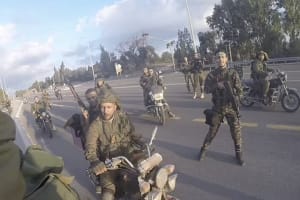Security cameras and a fence for each community: The outline for return of Gaza envelope residents to their homes
Residents are expected to return gradually, starting with communities located 4-7 km away from Gaza Strip. The IDF clarifies it cannot guarantee there is no security risk but notes the threat of raids and invasions has decreased significantly

The IDF is preparing for return of the residents of six Gaza envelope communities to their homes. Five of these communities are located 4 to 7 kilometers (2.5-4.25 miles) away from the Gaza border, while another, Yad Mordechai, is less than 4 kilometers (2.5 miles) away. Moreover, the returning residents will receive a homecoming grant, but those not wishing to return will not be forced to leave their hotels.
According to the plan, residents will return gradually, with the communities located 4 to 7 km away from the Gaza Strip returning first, and only after, the communities located closer to the Gaza Strip will follow suit. The gradual approach will also be applied geographically, with residents from communities north of the Gaza Envelope returning to their homes at the first stage, in light of the IDF’s battle achievements in the north.
The IDF explained that the return of residents to their communities would be conducted in close dialogue with the heads of the local authorities, due to a severe lack of confidence in the Israeli military among the residents in light of its failure during the 'Black Shabbat' massacre. Unlike in the past and due to the magnitude of the event, the Home Front Command is in direct dialogue not only with the heads of the local authorities but also with the community leaders themselves.
In general, the IDF pointed out, it is the older population that is very keen to return to their homes, but the families with the children are more concerned. Some of the families with small children have agreed to return on the condition that the military guarantees their security. The IDF admits that after Oct. 7, it is not possible to assure the residents that the security risk does not exist. However, they note that the threat of raids and infiltration has decreased significantly and while the rocket threat has not disappeared, it has decreased significantly as well.
The big change, the army explained, is the freedom of action inside the Gaza Strip for the Israeli security forces, and the change in the concept of defense that is currently taking shape. In this context, the IDF clarified that the military will maintain more forces on the border of the Gaza Strip and will continue conducting proactive offenses inside the Gaza Strip.
In addition, the IDF has developed a plan for securing the communities, dividing them according to their distance from the Gaza Strip and their security needs. Each community is expected to receive a tailored protective shell. Furthermore, the first responders' squads will become the "first response forces" and the number of members will increase significantly from 8 members per unit to 18 members and even more in certain communities. The IDF is talking about adding an armory in each community, a weapons safe for each member of the first responders' unit, an inductive fence, cameras, etc. These defense items will also be shared by the members of the first responders' units in the communities of Judea and Samaria, and along the confrontation line.
Also, the IDF is promoting the return of public transportation and healthcare services to the south of Israel. However, the IDF is aware that educational institutions will not operate in the south until the end of February, and without schools, families with children will not return to their homes. At the same time, the Defense Ministry's Directorate for Rehabilitation and Development conducted a mapping of all the communities located at a distance up to 4 kilometers (2.5 miles) from the Gaza border. The communities in this area that were destroyed during the surprise attack on Oct. 7 will receive interim solutions for six months – or even up to a year – until their houses are rebuilt.
The army explained that their approach is not to wait until the completion of the entire defense process before returning residents to their communities, however, some things can be done concurrently.
Written by KAN 11 correspondents Carmela Menashe and Itay Blumental.

Kan.org.il is the Hebrew news website of the The Israeli Public Broadcasting Corporation













